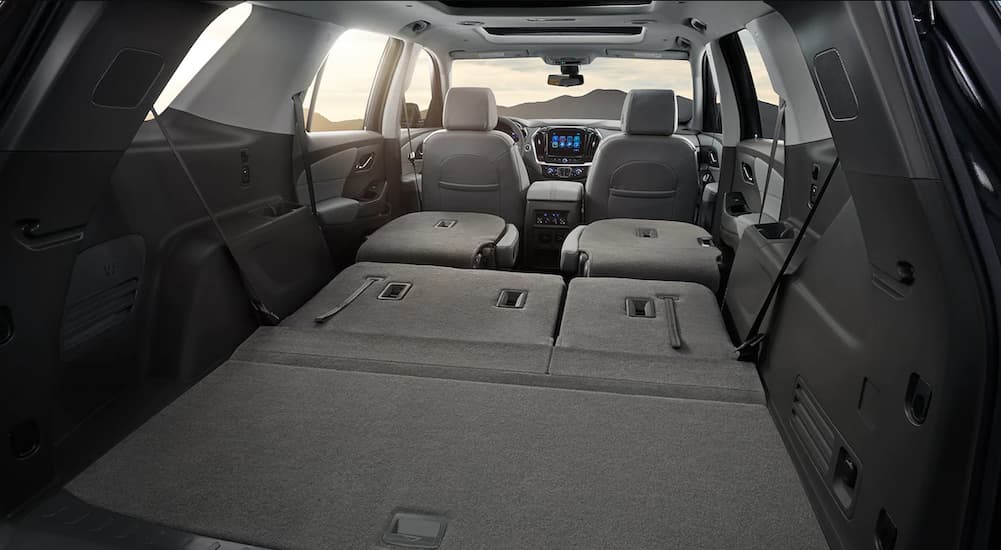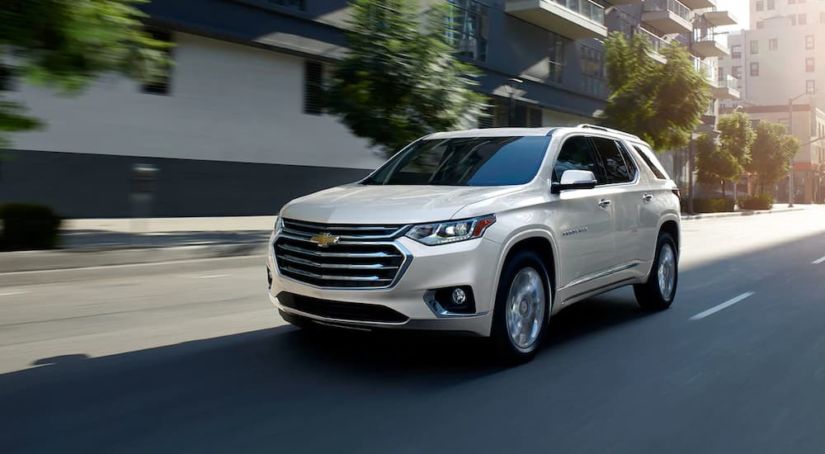When pitting two crossover Sport Utility Vehicles against one another, such as the 2019 Chevy Traverse vs 2019 Ford Explorer, the first thing that comes to mind is “Really? Is the Traverse really in the same league as the Ford Explorer?” As concerns full-sized SUVs and class assignment, turns out, yes it is. The Traverse is a child compared to the old man of the market, the Explorer. Not only that, the Traverse holds up fairly well against the much more recognizable Explorer. Naturally, they are very similar, as they appeal to the same demographic of drivers. Also to be expected, they have differences, because they pretty much have to. These are the two fiercest rivals in the American SUV market for a reason.
The Chevy Traverse came about in 2008, for the 2009 model year. It was the largest such vehicle at the time for Chevrolet, and it had big tires to fill. It would replace both the Chevrolet Trailblazer SUV and the Chevrolet Uplander minivan. That is a lot to ask from an SUV, but the Traverse has stepped up to the challenge and has had fairly even sales numbers, though nothing compared to the Ford Explorer.
The Ford Explorer is one of the elder statesmen in the group. It debuted in 1990 and has no major competition in its age bracket. The Jeep Grand Cherokee would come along in a couple of years, but that is as close to competition as the Explorer has seen in these nearly 30 years. Over those decades, the Ford Explorer has built a reputation for solid dependability and wildly successful popularity. As other automakers have built up and torn down SUV models (including Ford itself), the Ford Explorer has remained a hallmark of not just the SUV class, but the automotive market as a whole.
Let’s look at a couple of the needs that SUV buyers look at, and see which one comes out on top.
Engines
For many people, particularly SUV drivers, the engine is the starting point when looking at a vehicle. With some vehicles, it is also the stopping point. Some SUV drivers use their vehicles for off-roading, while others use it to tow recreational toys or work supplies. You have to have an engine that can haul around-literally tons of equipment. If the SUV in question comes up short, it is very easy to move on to the next one. The market is saturated with SUVs of all sizes, so finding the right amount of power for your dollar is very doable, it just takes some time and homework.
The 2019 Chevy Traverse comes with two engine options. The base option is a 3.6-liter V6 with 280 horsepower and 266 lb-ft of torque. That should be enough to get you and yours to where you need to be, provided you aren’t towing or hauling really heavy loads. The Traverse can handle up to 5,000 pounds, which is decent for this range.
The other engine option is a 2.0-liter turbocharged 4-cylinder engine that gets 257 horsepower and 295 lb-ft of torque. However, it is only available on the RS trim level, which is in the middle of the Traverse’s trim level lineup, and only in front wheel drive.
The 2019 Ford Explorer, on the other hand, has three engine options, each more powerful than those offered by the Chevy Traverse. The first is a 3.5-liter V6 with 290 horsepower and 255 lb-ft of torque. That is already better than the Traverse’s base engine, but Ford is not done yet. The next available engine is a 2.3-liter turbocharged 4-cylinder with 280 horsepower and 310 lb-ft of torque. The final, and most powerful engine on the 2019 Ford Explorer, goes to the 3.5-liter turbocharged V6 that gets a whopping 365 horsepower and 350 lb-ft of torque. That is far greater power than anything generated under the hood of a 2019 Chevy Traverse. It can also tow up to 5,600 pounds, slightly more than the Traverse.
Needless to say, if engine performance is a priority for you in an SUV, the 2019 Ford Explorer is the clear winner here. However, not everybody cares that deeply about what goes on in the engine department. Some care more about what goes on in the cabin.
Interiors

With the rise of the SUV came an inevitable evolution. These vehicles would eventually serve as minivan/station wagon/family car/utility vehicle all rolled into one. They have the power, size and comfort availability to get all the jobs done, without having to have a second (or third or fourth) car. As more and more people turn to their vehicles for homes away from their homes, and offices away from their offices, the SUV makers, like Ford and Chevy, have responded. Some have responded better than others, though.
The interior of the 2019 Chevy traverse boasts a total interior volume of 157.3 cubic feet. That is quite large, nearly as much interior room as the Traverse’s big brother, the Suburban. To break that down even further, the Traverse has 23.0 cubic feet of space when all seats are in their proper positions. When you fold the third row down, that number jumps way up to 57.8 cubic feet. When you fold the second row down, that number skyrockets to 157.3 cubic feet.
The 2019 Ford Explorer has three rows, as well, which can also be folded down to maximize its 151.7 cubic feet of space. When the third row is in place, it has 21.0 cubic feet of space. That is pretty close to the Traverse. Unfortunately, the numbers don’t get any closer the more rows you fold down.
The Explorer offers only 43.9 cubic feet of space when the third row is down, and a very underwhelming 81.7 cubic feet when the second row is down. Those numbers are pretty good, all things considered, but not nearly as spacious as what the 2019 Chevy Traverse can offer.
If you are one of those that wants to maximize your space in an SUV, and get every square inch you can for groceries, camping gear, sporting equipment, work projects or school supplies, the 2019 Chevy Traverse is the spacious SUV you need.
All in all, these two crossover SUVs are both very solid vehicles. Nothing really pops out at you about either. They aren’t class leaders in anything, they aren’t particularly flashy, they get average gas mileage (The Traverse is slightly better overall, much better on the highway), they have their pros, they have their cons, so on and so forth.
A decision like this might come down to one of two things – brand loyalty and price. Since these two are fierce rivals, they know that they have diehard Chevy fans and diehard Ford fans. This rivalry exists across all makes, models, shapes, sizes and years of head to head competition. A Ford fan is going to buy a Ford vehicle, and a Chevy fan is going to buy a Chevy vehicle. They aren’t going to debate it or even consider the possibility of switching party lines.
If you are not on one side of the aisle or the other, consider the price. The Chevy Traverse starts out at $29,930 MSRP, while the Ford Explorer will start at $32,365. Are you a fan of engines powerful enough to get the job done? Or are you a fan of a large, spacious SUV that can get a job done in more relative comfort? And are you willing to pay for it?



